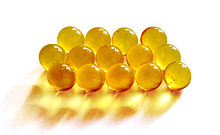Cod liver oil
Cod liver oil (obsolete "Fabriktran"; Oleum jecoris Aselli, oleum morrhuae) is a thin, light to brown-yellow oil , which is mainly from the liver from cod and haddock - but not from the Tran of whales was recovered -. However, other species such as hake , pollack , sharks and rays are also used for production.
In the past, it was obtained from fish livers that were stored under pressure until they rot, the rest was boiled and squeezed (brown, natural cod liver oil). Later it was obtained by boiling or using steam (steam oil, medicinal oil, light cod liver oil) and subsequent cooling below zero and filtration. "Pressed oil" can be obtained from the remains by pressing. There are also electrolytic processes for extracting oil.
It consists of easily digestible fat , which is composed of various fatty acids , 25% C18: 1 ( oleic acid , vaccenic acid ) and 11% palmitic acid , 9% palmitoleic acid , approximately 11% C20: 1 ( gadoleic acid , gondo acid ), as well as omega-3 -Fatty acids 11% C20: 5 eicosapentaenoic acid (EPA), 9% C22: 6 docosahexaenoic acid (DHA) and 1.5% 22: 5 docosapentaenoic acid , further 5.5% C22: 1 ( erucic acid , cetoleic acid ), and 3.5% Myristic acid . Cod liver oil also contains iodine , phosphorus , α– tocopherol 300 μg / g and relatively high amounts of vitamin A 2500 IU / g and D 40 IU / g, as well as 5.7 g / kg cholesterol .
Artificial vitamins are added subsequently to preparations with purified and deodorized cod liver oil.
history
Cod liver oil was used as a tonic by the Vikings , Norwegians , Eskimos , Laplanders and Greenlanders . Later in the 18th century it was recommended for the treatment of night blindness , rheumatism and rickets .
The excellent effectiveness of cod liver oil against rickets was discovered by German scientists in 1824, about two years after it became known that sunlight , in the form of the sun cures popular at the time, can also be used to prevent or treat this disease. It was not until 1922 that vitamin D 3 could be determined as the anti-rachitic component. The chemists Hans Brockmann and Adolf Windaus u. a. were able to isolate an active ingredient from fish liver oils in 1935: 7-dehydrocholesterol , the provitamin of vitamin D 3 .
Cod liver oil was also used as a lamp oil and impregnation agent.
application
Cod liver oil is used as a tonic particularly for childhood diseases and malnutrition as well as for the prevention of rickets (also English disease taken orally). Until the 1960s, children in Germany were often given a full spoon a day for prevention and strengthening. The taste is considered penetrating. Cod liver oil from canned cod liver , on the other hand, is an (edible) oil with only a subtle fish note.
If consumed too high, vitamin A can lead to hypervitaminosis .
Web links
literature
- Nicholas Eschenbruch (Ed.): Medicines of the 20th century. Historical sketches from cod liver oil to thalidomide. Transcript, Bielefeld 2009, ISBN 978-3-8376-1125-0 (= Science studies).
- G. Frerichs, G. Arends, H. Zörnig: Hagers Handbook of Pharmaceutical Practice. Volume 2, 2nd edition, Springer, 1938, ISBN 978-3-662-35502-2 , pp. 296, 298 f.
Individual evidence
- ↑ J. König : Chemistry of food and luxury items as well as everyday objects. Volume 2, 5th edition, Springer, 1920, ISBN 978-3-642-49527-4 , p. 328.
- ↑ Hellmut Gnamm, K. Grafe, L. Jablonski u. a .: Handbook of Gerbereichemie und Lederfabrikation. 3rd volume: Das Leder , 1st part, Springer, 1936, ISBN 978-3-7091-2211-2 (reprint), p. 347 ff.
- ^ Georg Lambertsen and Olaf R. Brækkan: The Fatty Acid Composition of Cod Liver Oil. Fiskeridirektøren, 1965, online (PDF; 246 kB).
- ^ Leo ML Nollet: Food Analysis by HPLC. Second Edition, Marcel Dekker, 2000, ISBN 0-8247-8460-X , p. 185.
- ^ Hager's Handbook of Pharmaceutical Practice. 1938.
- ↑ SF O'Keefe and RG Ackman: Vitamins A, D3 and E in Nova Scotian Cod Liver oils. In: Proc. NS Inst. Sci. Volume 37, 1986, pp. 1-7, online (PDF; 5.43 MB).
- ^ Fereidoon Shahidi: Nutraceutical and Specialty Lipids and their Co-Products. CRC Press, 2006, ISBN 1-57444-499-9 , p. 231.
- ↑ David Feldman, J. Wesley Pike, John S. Adams: Vitamin D. Third Edition, Vol. 1, Academic Press, 2011, ISBN 978-0-12-387035-3 , p. 88.
- ↑ Ensminger, Ensminger, Konlande, Robson: Foods & Nutrition Encyclopedia. Vol. 1: A-H , 2nd Edition, CRC Press, 1994, ISBN 0-8493-8981-X , p. 441.
- ↑ Glenn Sonnendecker: Kremers and Urdang's History of Pharmacy. 4th edition, 1976, American Institute of the History of Pharmacy, 1986, ISBN 0-931292-17-4 (Reprint), p. 504, 1st column.
- ^ Lee R. McDowell: Vitamin History, the Early Years. Univ. of Florida, 2013, ISBN 978-1-62287-266-4 .
- ↑ JH White & LR Tavera-Mendoza: The underrated sun vitamin. In: Spectrum of Science . Vol. 7, 2008, p. 40.
- ↑ Ronald Ross Watson: Handbook of Vitamin D in human health. Wageningen Academic, 2013, ISBN 978-90-8686-210-8 , pp. 14, 398.
- ^ PH List, L. Hörhammer: Hager's handbook of pharmaceutical practice. Volume 2, Active Ingredient Groups II: Chemicals and Drugs A-AL , 4th Edition, Springer, 1969, ISBN 978-0-387-04511-5 , p. 644.
- ^ Friedrich Klages : Introduction to organic chemistry. Walter de Gruyter & Co., Berlin 1961, p. 522.
- ^ Dietrich Sahrhage, Johannes Lundbeck: A History of Fishing. Springer, 1992, ISBN 978-3-642-77413-3 , p. 89.



